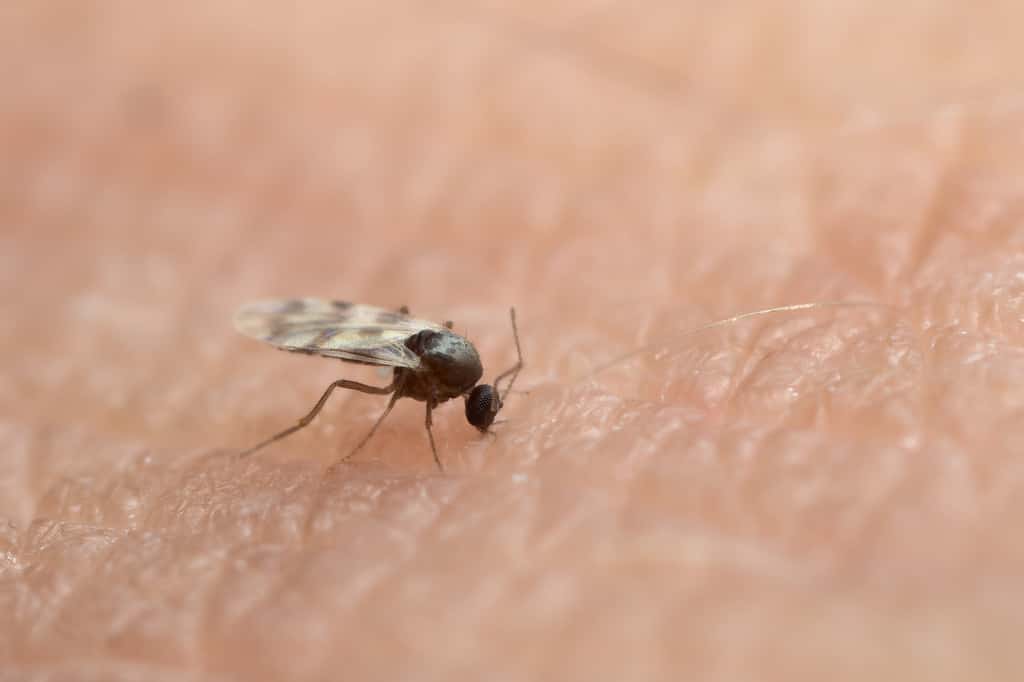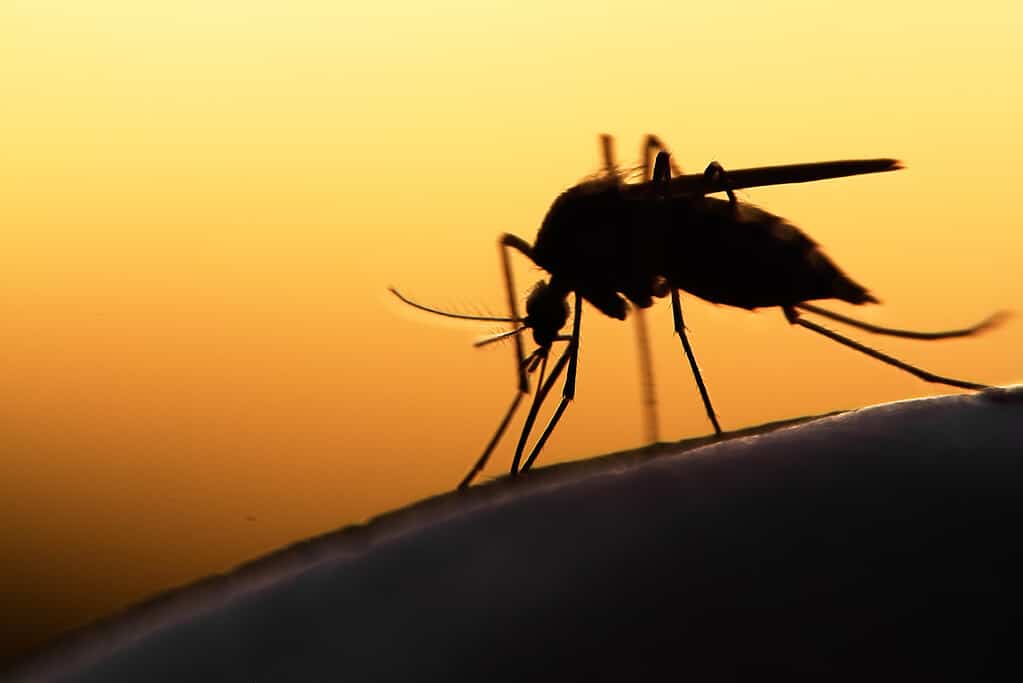Biting midges and mosquitoes are both flying, biting insects most of us prefer to stay far, far away from. Because these pesky bugs tend to be so bothersome and unpleasant, many people tend to lump the two together as if they were the same animal. However, the two are quite distinct from one another despite belonging to the same taxonomic suborder and being somewhat closely related.
Even if you’re not a fan of midges and mosquitoes, it can be helpful to understand the differences between the two for your safety, as well as how to correctly identify and deal with them if you encounter them. Let’s take a brief look at both below and the traits they have in common, and more importantly, their four key differences.
Mosquitoes and Midges: An Introduction
Like we just touched on above, mosquitoes and midges are fairly closely related despite being very distinct insects. But before we get into the main four differences between these insects, it’ll help to get a brief overview of each and understand what characteristics they share first.
Let’s begin with midges, also known as “no-see-ums” or “punkies” in the United States depending on the region. There are over 20,000 species worldwide. However, we’ll be focusing on the roughly 5,000 species of biting midges within the Ceratopogonidae family. More broadly speaking, they belong to the Diptera order of insects, which are known collectively as flies.
Compared to most other types of flies, biting midges are very small and short-lived. Though they mostly eat nectar, females feed on the blood of various species of animals just before laying eggs to get a boost of energy and protein. They have four sharp, serrated mouthparts housed within a tiny sheath ideal for piercing even the toughest and thickest animals’ skin. Their bites are notoriously itchy and painful despite their small size. They can also spread infectious diseases, primarily to livestock like horses, cattle, and sheep.
Meanwhile, mosquitoes also belong to the Diptera order, making them technically flies, too. They make up around 3,500 species within the Culicidae family. These small yet long, slender insects similarly have razor-sharp mouthparts that can pierce the skin of much larger animals, though theirs are long, hollow, and tube-like in the form of a proboscis.
Mosquitoes also primarily feed on nectar, but females require a blood meal to sustain themselves throughout the tiresome process of egg-laying. Just like midge bites, mosquito bites are itchy and painful. Mosquitoes can spread a wide range of nasty diseases to both humans and animals alike with said bite.

Midge vs. Mosquito: Size and Overall Appearance
Now that we better understand what midges and mosquitoes are and how they’re alike, let’s take a closer look at their key differences. The first and most obvious at a glance is the two insects’ size and overall appearance. Even though they’re both very small, superficially similar flies that can be tricky to view up close, it’s still possible to differentiate them fairly easily by a few main traits.
Midges and mosquitoes differ most when it comes to their overall body size. While midges are tiny at just 1 to 3 millimeters long on average, mosquitoes are around twice that size at anywhere from 3 to 6 millimeters in length. Both, however, have very narrow, slender bodies that can look slightly wider if engorged with blood.
Another key trait that differentiates mosquitoes from midges is the length of their wings. Midges have short wings that, depending on the species, are just as long as or shorter than their entire body. Mosquitoes, on the other hand, have longer wings that usually extend past the length of their body.
Apart from their sizes and proportions, midges and mosquitoes also have very differently shaped and sized mouthparts. Mosquitoes have a long, hollow, tube-like proboscis that is positioned on the front and center of the head. On midges, no proboscis is present–instead, they have very short yet serrated, pincer-like mouthparts in a short, fleshy sheath.
Finally, it’s also worth mentioning that mosquitoes and midges position their legs differently when at rest. While mosquitoes raise their rear two legs in the air when resting, midges lift their front two legs upward instead.

Biting midges are around half the size of mosquitoes on average.
©Henrik Larsson/Shutterstock.com
Midge vs. Mosquito: Lifespan
The next key difference we’ll cover isn’t as obvious at a glance, but it’s still important to recognize, as it influences the insects’ behavior and how long they tend to stick around. Midges and mosquitoes have fairly similar, straightforward life cycles that progress from egg to pupa to larva and, finally, imago or adult. Their overall lifespans, however, can differ drastically.
While the lifespans of non-biting midges are incredibly short at just five to seven days or so, biting midges are much longer-lived by comparison at around two to six weeks at most. Both varieties of midges, though, generally only live just long enough to mate and lay eggs. As a result, the males have much shorter lifespans than the females, essentially existing to mate and die.
But mosquitoes can live for anywhere from just under a week to up to seven months. The exact length of a mosquito’s lifespan depends on the species, whether the mosquito is male or female, and the conditions in which it lives. Like midges, female mosquitoes live longer than males. Females with access to a steady supply of food can survive for several months. Although they only mate once, females can store sperm in their bodies for their entire lives, waiting for conditions to be ideal.

Mosquitoes can live for several months, while midges’ lifespans are much shorter.
©mycteria/Shutterstock.com
Midge vs. Mosquito: Swarming Behavior
Another very obvious difference between mosquitoes and midges is their behavior, or more specifically, how they move and interact with one another. Even though both insects are capable of forming swarms, the way they do so and the conditions in which they swarm are unique from one another.
In general, you’re more likely to see a midge swarm than a swarm of mosquitoes. This is because both non-biting and biting midges form large mating swarms, typically in the evening hours. These swarms are usually large groups of newly-hatched adult male midges attempting to attract female mates. These swarms emerge from the water as the midge pupae hatch together and rush to find a mate within their incredibly short lifespan. This also means more frequent swarms, as their life cycles move a lot faster than mosquitoes do.
Mosquito swarms, on the other hand, are usually much smaller, less centralized, and more difficult to see from a distance. They don’t tend to hatch from their pupa stage in massive groups quite like midges do. As a result, their swarms are far less dense and more spread apart. Mosquitoes also move more slowly in the air than midges. This means their swarms are much less speedy, chaotic, and frantic by comparison.
In short, you’d probably be able to spot a midge swarm even from a distance, but mosquito swarms aren’t as noticeable. Like midge swarms, though, mosquito swarms are made up of males seeking female mates.

Mosquitoes fly much more slowly than midges, and mosquito swarms are smaller and less dense than midge swarms.
©iStock.com/Kwangmoozaa
Midge vs. Mosquito: Bite and Health Risks to Humans
Finally, let’s address the most unpleasant difference between midges and mosquitoes: their bites. Both biting midges and mosquitoes are capable of inflicting painful and itchy bites on their unfortunate victims. However, their bites and the symptoms associated with them are different. It’s also important to note that, unlike mosquitoes, biting midges thankfully do not spread diseases to humans.
As we touched on earlier, midges and mosquitoes have very differently-shaped mouthparts. Because of this, the bites they can deliver are also unique from one another. If you’re bitten by a biting midge, you’re going to notice it immediately. This is thanks to the midge’s four serrated, knife-like mouthparts piercing your skin. Many unfortunate victims describe the initial bite as a painful, burning sensation that eventually becomes itchy and irritated.
A mosquito bite, however, isn’t noticeable until minutes or even hours after the fact. This is due to the unique anesthetic and anticoagulant combo present in mosquito saliva. This essentially numbs the bite area and prevents your blood from clotting. This, in turn, allows the mosquito to gulp down as much of your blood as they please with their long, thin proboscis without you noticing–until it starts to itch later when that anesthetic wears off.
To sum up, mosquito bites don’t hurt at first, but they gradually become itchy and irritated after the mosquito’s saliva leaves your system. Midge bites, however, are initially very painful, though the pain dulls over time and becomes a more itchy sensation. But both insects’ bites usually appear as small, red bumps. These bumps can become more inflamed if you continue to scratch or irritate them.

Midge bites can be very painful due to the insects’ serrated, sharp mouthparts.
©Jamierpc/Shutterstock.com
Thank you for reading! Have some feedback for us? Contact the AZ Animals editorial team.








